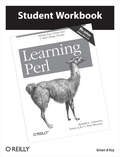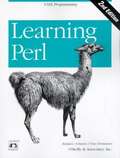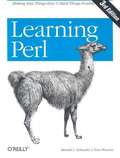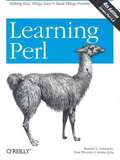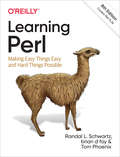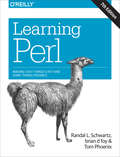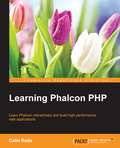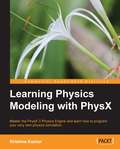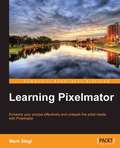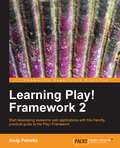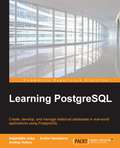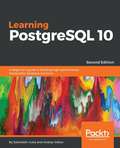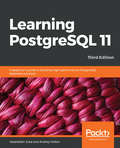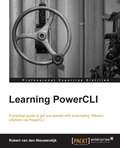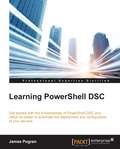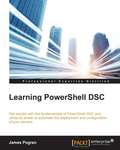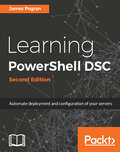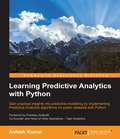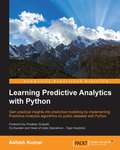- Table View
- List View
Learning Perl Student Workbook
by Brian D FoyIf you’re a programmer, system administrator, or web hacker just getting started with Perl, this workbook helps you gain hands-on experience with the language right away. It’s the perfect companion to the 6th Edition of Learning Perl (known as “the Llama”), which is based on the popular introductory Perl course taught by the book’s authors since 1991.The first half of this workbook presents the exercises, with answers in the second half. The material covers Perl up to version 5.14.Topics include:Scalar DataLists and ArraysSubroutinesInput and OutputHashesRegular ExpressionsControl StructuresPerl ModulesFile TestsDirectory OperationsStrings and SortingSmart MatchingProcess ManagementSome Advanced Perl TechniquesDatabases
Learning Perl on Win32 Systems
by Tom Christiansen Erik Olson Randal L. SchwartzIn this carefully paced course, leading Perl trainers and a Windows NT practitioner teach you to program in the language that promises to emerge as the scripting language of choice on NT. Based on the "llama" book, this book features tips for PC users and new NT-specific examples, along with a foreword by Larry Wall, the creator of Perl, and Dick Hardt, the creator of Perl for Win32.
Learning Perl on Win32 Systems
by Tom Christiansen Erik Olson Randal L. SchwartzIn this smooth, carefully paced course, leading Perl trainers and a Windows NT practitioner teach you to program in the language that promises to emerge as the scripting language of choice on NT. With a foreword by Larry Wall, the creator of Perl, this book is the "official" guide for both formal (classroom) and informal learning. Based on the "llama book," Learning Perl on Win32 Systems features tips for PC users and new NT-specific examples. Perl for Win32 is a language for easily manipulating text, files, user and group profiles, performance and event logs, and registry entries, and a distribution is available on the Windows NT Resource Kit. Peer-to-peer technical support is now available on the perl.win32.users mailing list. The contents include: An introduction to "the Perl way" for Windows users A quick tutorial stroll through Perl in one lesson Systematic, topic-by-topic coverage of Perl's broad capabilities Innumerable, brief code examples Programming exercises for each topic, with fully worked-out answers Access to NT system functions through Perl Database access with Perl CGI programming with Perl Erik Olson is director of advanced technologies for Axiom Technologies, LC, where he specializes in providing Win32 development solutions. Randal L. Schwartz and Tom Christiansen have also written Programming Perl, co-authored with Larry Wall and published by O'Reilly and Associates.
Learning Perl, 2nd Edition
by Tom Christiansen Randal L. SchwartzIn this update of a bestseller, two leading Perl trainers teach you to use the most universal scripting language in the age of the World Wide Web. With a foreword by Larry Wall, the creator of Perl, this smooth, carefully paced book is the "official" guide for both formal (classroom) and informal learning. It is now current for Perl version 5.004. Learning Perl is a hands-on tutorial designed to get you writing useful Perl scripts as quickly as possible. Exercises (with complete solutions) accompany each chapter. A lengthy new chapter in this edition introduces you to CGI programming, while touching also on the use of library modules, references, and Perl's object-oriented constructs. Perl is a language for easily manipulating text, files, and processes. It comes standard on most UNIX platforms and is available free of charge on all other important operating systems. Perl technical support is informally available -- often within minutes -- from a pool of experts who monitor a USENET newsgroup (comp.lang.perl.misc) with tens of thousands of readers. Contents include: A quick tutorial stroll through Perl basics Systematic, topic-by-topic coverage of Perl's broad capabilities Lots of brief code examples Programming exercises for each topic, with fully worked-out answers How to execute system commands from your Perl program How to manage DBM databases using Perl An introduction to CGI programming for the Web
Learning Perl, 3rd Edition
by Randal L. Schwartz Tom PhoenixLearning Perlis the quintessential tutorial for the Perl programming language. The third edition has not only been updated to Perl Version 5.6, but has also been rewritten from the ground up to reflect the needs of programmers learning Perl today. Other books may teach you to program in Perl, but this book will turn you into a Perl programmer.
Learning Perl, 3rd Edition
by Randal L. Schwartz Tom PhoenixLearning Perl, popularly known as "the Llama," is the book most programmers rely on to get started with Perl. The bestselling Perl tutorial since it was first published in 1993, this new fifth edition covers recent changes to the language up to Perl 3. Reflecting years of classroom testing and experience, this edition is packed with exercises that let you practice the concepts while you follow the text.
Learning Perl, 4th Edition
by Randal L. Schwartz Tom Phoenix Brian D. FoyLearning Perl , better known as "the Llama book", starts the programmer on the way to mastery. Written by three prominent members of the Perl community who each have several years of experience teaching Perl around the world, this latest edition has been updated to account for all the recent changes to the language up to Perl 5.8. Perl is the language for people who want to get work done. It started as a tool for UNIX system administrators who needed something powerful for small tasks. Since then, Perl has blossomed into a full-featured programming language used for web programming, database manipulation, XML processing, and system administration--on practically all platforms--while remaining the favorite tool for the small daily tasks it was designed for. You might start using Perl because you need it, but you'll continue to use it because you love it. Informed by their years of success at teaching Perl as consultants, the authors have re-engineered the Llama to better match the pace and scope appropriate for readers getting started with Perl, while retaining the detailed discussion, thorough examples, and eclectic wit for which the Llama is famous. The book includes new exercises and solutions so you can practice what you've learned while it's still fresh in your mind. Here are just some of the topics covered: data structures minimal matching threading data parsing references objects modules package implementation If you ask Perl programmers today what book they relied on most when they were learning Perl, you'll find that an overwhelming majority will point to the Llama. With good reason. Other books may teach you to program in Perl, but this book will turn you into a Perl programmer.
Learning Perl: Making Easy Things Easy and Hard Things Possible
by Randal L. Schwartz Tom Phoenix Brian D FoyIf you're just getting started with Perl, this is the book you want—whether you're a programmer, system administrator, or web hacker. Nicknamed "the Llama" by two generations of users, this best seller closely follows the popular introductory Perl course taught by the authors since 1991. This eighth edition covers recent changes to the language up to version 5.34.Perl is suitable for almost any task on almost any platform, from short fixes to complete web applications. Learning Perl teaches you the basics and shows you how to write simple, single-file programs—roughly 90% of the Perl programs in use today. And each chapter includes exercises to help you practice what you've just learned. Other books may teach you to program in Perl, but this book will turn you into a Perl programmer.Topics include:Perl data and variable typesSubroutinesFile operationsRegular expressionsString manipulation (including Unicode)Lists and sortingProcess managementUse of third-party modules
Learning Perl: Making Easy Things Easy and Hard Things Possible (In a Nutshell)
by Randal L. Schwartz Tom Phoenix Brian D FoyIf you're just getting started with Perl, this is the book you want--whether you're a programmer, system administrator, or web hacker. Nicknamed "the Llama" by two generations of users, this bestseller closely follows the popular introductory Perl course taught by the authors since 1991. This seventh edition covers recent changes to the language up to version 5.24.Perl is suitable for almost any task on almost any platform, from short fixes to complete web applications. Learning Perl teaches you the basics and shows you how to write programs up to 128 lines long--roughly the size of 90% of the Perl programs in use today. Each chapter includes exercises to help you practice what you've just learned. Other books may teach you to program in Perl, but this book will turn you into a Perl programmer.Topics include:Perl data and variable typesSubroutinesFile operationsRegular expressionsString manipulation (including Unicode)Lists and sortingProcess managementSmart matchingUse of third party modules
Learning Phalcon PHP
by Calin RadaLearn Phalcon interactively and build high performance web applications About This Book * Learn how to install and configure Phalcon PHP on your server * Develop a fully functional multi-module application with Phalcon PHP * A step-by-step guide with in-depth coverage of Phalcon and best practices Who This Book Is For If you are a web developer and want to build effective web applications with Phalcon PHP, then this book is ideal for you. The book does not assume detailed knowledge of PHP frameworks. What You Will Learn * Compile and install Phalcon from source code * Set up an MVC project and learn how to use the Dependency Injection (DI), configuration, and routing * Get to grips with Phalcon's ORM, ODM, validation and caching, and generate models using Phalcon Developer Tools * Create a command-line application from scratch * Write a fully functional REST module with Phalcon PHP * Use Volt as template engine to create your first views * Understand how session works and learn how to implement an authentication system In Detail Phalcon is a full-stack PHP framework implemented as a C extension. Building applications with Phalcon will offer you lower resource consumption and high performance whether your application runs on a Linux machine or a Windows one. Phalcon is loosely coupled, allowing you to use its objects as glue components based on the needs of your application. Phalcon PHP's mission is to give you an advanced tool to develop faster websites and applications. This book covers the most common and useful parts of PhalconPHP, which will guide you to make the right decisions while developing a Phalcon-driven application. You will begin the journey by installing and setting up Phalcon for your environment followed by the development of each module. You will be introduced to Phalcon's ORM and ODM. Furthermore, you will also be able to create the first models and database architecture for your project. You will then cover command-line applications, API module, volt syntax, and hierarchical views. Installing and working with Node and Bower for assets management will also be covered. Finally, you will gain insights into creating the backoffice and frontend module along with best practices and resources for development with Phalcon PHP. By the end of this book, you will be able to confidently develop any kind of application using the Phalcon PHP framework in a short time. Style and approach This step-by-step guide will walk you through the fundamentals of Phalcon PHP. It will then help you to create a simple but fully functional news website and gain advanced knowledge of how Phalcon PHP works.
Learning Physics Modeling with PhysX
by Krishna KumarWritten as a practical, step-by-step tutorial, this book is full of engaging examples to help you learn in a practical context.This book is for game developers or anyone who wants to learn how to fully utilize the PhysX Physics Engine quickly and efficiently. You don't have to be a die-hard programmer to get started with this book. Basic knowledge of C++, 3D mathematics, and OpenGL is all you need.
Learning Pixelmator
by Mark StagiA fast paced, example driven approach to learning Pixelmator."Learning Pixelmator" is great for photographers of any level who are looking to learn to take advantage of Pixelmator to edit images. Without any prior knowledge of image editing software needed, we will start with the basics and move onto more advanced image editing techniques. No matter what your current artistic level is, this book will give you the power to unleash the artist within!
Learning Play! Framework 2
by Andy PetrellaA strong focus is placed on explanation by example; even with the amount of amazing capabilities of Play! 2, they will be gathered in a single application. At the end of this book, the reader will have a fully-fledged application using the basic and advanced features of Play! 2. Readers must be interested in the Web in general; specifically using the HTTP between a browser and a server to create blazing projects! Java skills are beneficial but not necessary since Play! Framework 2 is not J2EE based but introduces a simple, neat, and completely integrated version; the prerequisites are almost none.
Learning PostgreSQL
by Achim Vannahme Salahaldin Juba Andrey VolkovCreate, develop and manage relational databases in real world applications using PostgreSQL About This Book * Learn about the PostgreSQL development life cycle including its testing and refactoring * Build productive database solutions and use them in Java applications * A comprehensive guide to learn about SQL, PostgreSQL procedural language and PL/pgSQL Who This Book Is For If you are a student, database developer or an administrator, interested in developing and maintaining a PostgreSQL database, then this book is for you. No knowledge of database programming or administration is necessary. Readers should, however, know SQL. What You Will Learn * Learn concepts of data modelling and relation algebra * Install and set up PostgreSQL database server and client software * Implement data structures in PostgreSQL * Manipulate data in the database using SQL * Implement data processing logic in the database with stored functions, triggers and views * Test database solutions and assess the performance * Integrate database with Java applications * Detailed knowledge of the main PostgreSQL building objects, most used extensions * Practice database development life cycle including analysis, modelling, (documentation), testing, bug fixes and refactoring In Detail PostgreSQL is one of the most powerful and easy to use database management systems. It has strong support from the community and is being actively developed with a new release every year. PostgreSQL supports the most advanced features included in SQL standards. Also it provides NoSQL capabilities, and very rich data types and extensions. All that makes PostgreSQL a very attractive solution in various kinds of software systems. The book starts with the introduction of relational databases with PostegreSQL. It then moves on to covering data definition language (DDL) with emphasis on PostgreSQL and common DDL commands supported by ANSI SQL. You will then learn the data manipulation language (DML), and advanced topics like locking and multi version concurrency control (MVCC). This will give you a very robust background to tune and troubleshoot your application. The book then covers the implementation of data models in the database such as creating tables, setting up integrity constraints, building indexes, defining views and other schema objects. Next, it will give you an overview about the NoSQL capabilities of PostgreSQL along with Hstore, XML, Json and arrays. Finally by the end of the book, you'll learn to use the JDBC driver and manipulate data objects in the Hibernate framework. Style and approach An easy-to-follow guide to learn programming build applications with PostgreSQL, and manage a PostgreSQL database instance.
Learning PostgreSQL 10 - Second Edition: A beginner's guide to building high-performance PostgreSQL database solutions
by Salahaldin Juba Andrey VolkovLeverage the power of PostgreSQL 10 to build powerful database and data warehousing applications. About This Book • Be introduced to the concept of relational databases and PostgreSQL, one of the fastest growing open source databases in the world • Learn client-side and server-side programming in PostgreSQL, and how to administer PostgreSQL databases • Discover tips on implementing efficient database solutions with PostgreSQL 10 Who This Book Is For If you're interested in learning more about PostgreSQL - one of the most popular relational databases in the world, then this book is for you. Those looking to build solid database or data warehousing applications with PostgreSQL 10 will also find this book a useful resource. No prior knowledge of database programming or administration is required to get started with this book. What You Will Learn • Understand the fundamentals of relational databases, relational algebra, and data modeling • Install a PostgreSQL cluster, create a database, and implement your data model • Create tables and views, define indexes, and implement triggers, stored procedures, and other schema objects • Use the Structured Query Language (SQL) to manipulate data in the database • Implement business logic on the server side with triggers and stored procedures using PL/pgSQL • Make use of advanced data types supported by PostgreSQL 10: Arrays, hstore, JSONB, and others • Develop OLAP database solutions using the most recent features of PostgreSQL 10 • Connect your Python applications to a PostgreSQL database and work with the data efficiently • Test your database code, find bottlenecks, improve performance, and enhance the reliability of the database applications In Detail PostgreSQL is one of the most popular open source databases in the world, and supports the most advanced features included in SQL standards and beyond. This book will familiarize you with the latest new features released in PostgreSQL 10, and get you up and running with building efficient PostgreSQL database solutions from scratch. We'll start with the concepts of relational databases and their core principles. Then you'll get a thorough introduction to PostgreSQL and the new features introduced in PostgreSQL 10. We'll cover the Data Definition Language (DDL) with an emphasis on PostgreSQL, and the common DDL commands supported by ANSI SQL. You'll learn to create tables, define integrity constraints, build indexes, and set up views and other schema objects. Moving on, you'll get to know the concepts of Data Manipulation Language (DML) and PostgreSQL server-side programming capabilities using PL/pgSQL. This will give you a very robust background to develop, tune, test, and troubleshoot your database application. We'll also explore the NoSQL capabilities of PostgreSQL and connect to your PostgreSQL database to manipulate data objects. By the end of this book, you'll have a thorough understanding of the basics of PostgreSQL 10 and will have the necessary skills to build efficient database solutions. Style and approach This book is a comprehensive beginner level tutorial on PostgreSQL and introduces the features of the newest version 10, along with explanation of concepts in a very easy to understand manner. Practical tips and examples are provided at every step to ensure you are able to grasp each topic as quickly as possible.
Learning PostgreSQL 10, Second Edtion
by Salahaldin Juba<P><P>Leverage the power of PostgreSQL 10 to build powerful database and data warehousing applications <P><P>Key Features <P><P>Be introduced to the concept of relational databases and PostgreSQL <P><P>Learn client-side and server-side programming in PostgreSQL and administer PostgreSQL databases <P><P>Discover tips on implementing efficient database solutions with PostgreSQL 10 <P><P>Book Description <P><P>PostgreSQL is one of the most popular open source databases in the world and supports the most advanced features included in SQL standards and beyond. This book will familiarize you with the latest new features released in PostgreSQL 10, and get you up and running with building efficient PostgreSQL database solutions from scratch. <P><P>We'll start with the concepts of relational databases and their core principles. Then, you'll get a thorough introduction to PostgreSQL and the new features introduced in PostgreSQL 10. We'll cover the Data Definition Language (DDL) with an emphasis on PostgreSQL, and the common DDL commands supported by ANSI SQL. You'll learn to create tables, define integrity constraints, build indexes, and set up views and other schema objects. <P><P>Moving on, you'll get to know the concepts of Data Manipulation Language (DML) and PostgreSQL server-side programming capabilities using PL/pgSQL. This will give you a very robust background to develop, tune, test, and troubleshoot your database application. We'll also explore NoSQL capabilities of PostgreSQL and connect to your PostgreSQL database to manipulate data objects. <P><P>By the end of this book, you'll have a thorough understanding of the basics of PostgreSQL 10 and will have the necessary skills to build efficient <P><P>What you will learn <P><P>Understand the fundamentals of relational databases, relational algebra, and data modeling <P><P>Install a PostgreSQL cluster, create a database, and implement your data model <P><P>Create tables and views, define indexes, and implement triggers, stored procedures, and other schema objects <P><P>Use the Structured Query Language (SQL) to manipulate data in the database <P><P>Implement business logic on the server side with triggers and stored procedures using PL/pgSQL <P><P>Make use of advanced data types supported by PostgreSQL 10: Arrays, hstore, JSONB, and others <P><P>Develop OLAP database solutions using the most recent features of PostgreSQL 10 <P><P>Connect your Python applications to a PostgreSQL database and work with the data efficiently <P><P>Test your database code, find bottlenecks, improve performance, and enhance the reliability of the database applications
Learning PostgreSQL 11: A beginner's guide to building high-performance PostgreSQL database solutions, 3rd Edition
by Salahaldin Juba Andrey VolkovLeverage the power of PostgreSQL 11 to build powerful database and data warehousing applications Key Features Monitor, secure, and fine-tune your PostgreSQL 11 database Learn client-side and server-side programming using SQL and PL/pgSQL Discover tips on implementing efficient database solutions Book Description PostgreSQL is one of the most popular open source database management systems in the world, and it supports advanced features included in SQL standards. This book will familiarize you with the latest features in PostgreSQL 11, and get you up and running with building efficient PostgreSQL database solutions from scratch. Learning PostgreSQL, 11 begins by covering the concepts of relational databases and their core principles. You'll explore the Data Definition Language (DDL) and commonly used DDL commands supported by ANSI SQL. You'll also learn how to create tables, define integrity constraints, build indexes, and set up views and other schema objects. As you advance, you'll come to understand Data Manipulation Language (DML) and server-side programming capabilities using PL/pgSQL, giving you a robust background to develop, tune, test, and troubleshoot your database application. The book will guide you in exploring NoSQL capabilities and connecting to your database to manipulate data objects. You'll get to grips with using data warehousing in analytical solutions and reports, and scaling the database for high availability and performance. By the end of this book, you'll have gained a thorough understanding of PostgreSQL 11 and developed the necessary skills to build efficient database solutions. What you will learn Understand the basics of relational databases, relational algebra, and data modeling Install a PostgreSQL server, create a database, and implement your data model Create tables and views, define indexes and stored procedures, and implement triggers Make use of advanced data types such as Arrays, hstore, and JSONB Connect your Python applications to PostgreSQL and work with data efficiently Identify bottlenecks to enhance reliability and performance of database applications Who this book is for This book is for you if you're interested in learning about PostgreSQL from scratch. Those looking to build solid database or data warehousing applications or wanting to get up to speed with the latest features of PostgreSQL 11 will also find this book useful. No prior knowledge of database programming or administration is required to get started.
Learning PowerCLI
by Robert Van Nieuwendijk"Learning PowerCLI" is written in a friendly and practical style with a focus on getting you started and automating daily tasks quickly and efficiently. If you manage or administrate a vSphere environment, and want to make that easier and more efficient, then this book is for you! This book is ideal for you if you want to learn how to automate your VMware vSphere infrastructure, by getting the most out of PowerCLI. It's assumed that you have some experience in administrating a VMware vSphere environment. Knowledge of Microsoft's Windows PowerShell is not a prerequisite.
Learning PowerCLI - Second Edition
by Robert Van NieuwendijkLearn to leverage the power of PowerCLI to automate your VMware vSphere environment with ease About This Book • This is first book on the market that will enlighten you on the latest version of PowerCLI and how to implement it • Effectively manage virtual machines, networks, and reports with the latest features of PowerCLI • A comprehensive and practical book on automating VMware vSphere Who This Book Is For This book is ideal for you if you want to learn how to automate your VMware vSphere or vCloud infrastructure by getting the most out of PowerCLI. It's assumed that you have some experience in administrating a vSphere or vCloud environment. Knowledge of Microsoft's Windows PowerShell is not a prerequisite. What You Will Learn • Explore PowerShell and PowerCLI cmdlets and their output objects • See how to manage virtual machines and work with virtual networks • Manage vCloud Director from PowerCLI • Use Site Recovery Manager from PowerCLI to create a disaster recovery solution • Manage NSX and vRealize Automation using REST API with PowerCLI • Create and configure vSphere HA and DRS clusters • Use vSphere Update Manager with PowerCLI to create patch baselines and scan hosts • Explore reporting techniques to retrieve log files In Detail VMware vSphere PowerCLI, a free extension to Microsoft Windows PowerShell, enables you to automate the management of a VMware vSphere or vCloud environment. This book will show you how to automate your tasks and make your job easier. Starting with an introduction to the basics of PowerCLI, the book will teach you how to manage your vSphere and vCloud infrastructure from the command line. To help you manage a vSphere host overall, you will learn how to manage vSphere ESXi hosts, host profiles, host services, host firewall, and deploy and upgrade ESXi hosts using Image Builder and Auto Deploy. The next chapter will not only teach you how to create datastore and datastore clusters, but you'll also work with profile-driven and policy-based storage to manage your storage. To create a disaster recovery solution and retrieve information from vRealize Operations, you will learn how to use Site Recovery Manager and vRealize Operations respectively. Towards the end, you'll see how to use the REST APIs from PowerShell to manage NSX and vRealize Automation and create patch baselines, scan hosts against the baselines for missing patches, and re-mediate hosts. By the end of the book, you will be capable of using the best tool to automate the management and configuration of VMware vSphere. Style and approach This comprehensive book will teach system administrators everything about PowerCLI 6 and how to utilize it to automate VMware vSphere.
Learning PowerShell DSC
by James PogranGet started with the fundamentals of PowerShell DSC and utilize its power to automate deployment and configuration of your serversAbout This BookCreate flexible and maintainable deployments using DSC configuration scripts that stand the test of timeExplore the in depth details of the core architecture, concepts, and practices used by PowerShell DSCA step-by-step guide that shows you how to start using and taking advantage of PowerShell DSCWho This Book Is ForThis book is intended for system administrators, developers, or engineers who are responsible for configuration management and automation and wish to learn PowerShell Desired State Configuration for efficient management, configuration and deployment of systems and applications.What You Will LearnUnderstand configuration management and why you need itCraft flexible, reusable, and maintainable configuration scripts for thousands of serversCreate custom DSC resources to manage any application or server settingApply configuration data to deploy applications to different environmentsUtilize DSC push deployments to test your configuration scripts and custom DSC resourcesInstall, configure and use DSC pull serversRun a Windows MSI packageDeploy a websiteIn DetailWindows PowerShell is a task-based command-line shell and scripting language designed especially for system administration. PowerShell DSC is a new management platform that enables you to deploy and manage configuration data for software services and manage the environment in which these services run.This book begins with an overview of the basics of PowerShell DSC by covering the architecture and components of the Desired Sate Configuration. It will then familiarize you with the set of PowerShell language extensions and new PowerShell commands. It will help you understand and create DSC configurations with the help of practical examples, and to create DSC custom resources for your custom applications. Finally, you will learn to deploy a real world application using PowerShell DSC. By the end of the book, you will have better knowledge about the powerful Desired State Configuration platform, which helps you to achieve continuous delivery, and efficient management and easy deployment of data for systems.Style and approachThis book is an in-depth guide to using PowerShell DSC, full of real-world experiences and best practices using PowerShell DSC. The topics are explained and build on one another other to provide a holistic learning experience. At the end, all the features learned will be used to create a real world application deployment using DSC.
Learning PowerShell DSC
by James Pogran<P><P>Get started with the fundamentals of PowerShell DSC and utilize its power to automate deployment and configuration of your servers <P><P>About This Book <P><P>Create flexible and maintainable deployments using DSC configuration scripts that stand the test of time <P><P>Explore the in depth details of the core architecture, concepts, and practices used by PowerShell DSC <P><P>A step-by-step guide that shows you how to start using and taking advantage of PowerShell DSC <P><P>Who This Book Is For <P><P>This book is intended for system administrators, developers, or engineers who are responsible for configuration management and automation and wish to learn PowerShell Desired State Configuration for efficient management, configuration and deployment of systems and applications. <P><P>What You Will Learn <P><P>Understand configuration management and why you need it <P><P>Craft flexible, reusable, and maintainable configuration scripts for thousands of servers <P><P>Create custom DSC resources to manage any application or server setting <P><P>Apply configuration data to deploy applications to different environments <P><P>Utilize DSC push deployments to test your configuration scripts and custom DSC resources <P><P>Install, configure and use DSC pull servers <P><P>Run a Windows MSI package <P><P>Deploy a website <P><P>In Detail <P><P>Windows PowerShell is a task-based command-line shell and scripting language designed especially for system administration. PowerShell DSC is a new management platform that enables you to deploy and manage configuration data for software services and manage the environment in which these services run. <P><P>This book begins with an overview of the basics of PowerShell DSC by covering the architecture and components of the Desired Sate Configuration. It will then familiarize you with the set of PowerShell language extensions and new PowerShell commands. It will help you understand and create DSC configurations with the help of practical examples, and to create DSC custom resources for your custom applications. Finally, you will learn to deploy a real world application using PowerShell DSC. By the end of the book, you will have better knowledge about the powerful Desired State Configuration platform, which helps you to achieve continuous delivery, and efficient management and easy deployment of data for systems.
Learning PowerShell DSC - Second Edition
by James PogranA learning guide to get you started with PowerShell DSC. About This Book • Create flexible and maintainable deployments using DSC configuration scripts that stand the test of time. • Explore the core architecture, concepts, and practices in depth. • Learning PowerShell DSC is a step-by-step guide that shows you how to start using and taking advantage of PowerShell DSC along with configuring and deploying applications. Who This Book Is For If you are a system administrator, developer, or engineer and are responsible for configuration management and automation, then this book is for you. IT professionals who wish to learn PowerShell Desired State Configuration for the efficient management, configuration, and deployment of systems will also find this book useful. What You Will Learn • Explore PowerShell Desired State Configuration and activities around it, including the need for configuration management and abstraction. • Create reusable DSC configurations and debug/ troubleshoot configuration files. • Learn about the PowerShell DSC architecture with the help of push-and-pull management and workflows. • Define DSC configuration scripts and data files and push DSC configuration files remotely and locally. • Validate DSC Pull Server install and register target nodes with a DSC Pull Server. • Learn about DSC Cross Platform and install PowerShell on Linux and macOS along with real-life DSC uses and different types of deployment. In Detail The main goal of this book is to teach you to configure, deploy, and manage your system using the new features of PowerShell v5/v6 DSC. This book begins with the basics of PowerShell Desired State Configuration, covering its architecture and components. It familiarizes you with the set of Windows PowerShell language extensions and new Windows PowerShell commands that make up DSC. Then it helps you create DSC custom resources and work with DSC configurations with the help of practical examples. Finally, it describes how to deploy configuration data using PowerShell DSC. Throughout this book, we will be focusing on concepts such as building configurations with parameters, the local configuration manager, and testing and restoring configurations using PowerShell DSC. By the end of the book, you will be able to deploy a real-world application end-to-end and will be familiar enough with the powerful Desired State Configuration platform to achieve continuous delivery and efficiently and easily manage and deploy data for systems. Style and approach The purpose of this book is to introduce readers to the powerful PowerShell Desired State Configuration platform to achieve continuous delivery, efficient management, and the easy deployment of data for systems.
Learning PowerShell DSC: Automate deployment and configuration of your servers
by James PogranA learning guide to get you started with PowerShell DSC.Key FeaturesCreate flexible and maintainable deployments using DSC configuration scripts that stand the test of time.Explore the core architecture, concepts, and practices in depth.Learning PowerShell DSC is a step-by-step guide that shows you how to start using and taking advantage of PowerShell DSC along with configuring and deploying applications.Book DescriptionThe main goal of this book is to teach you to configure, deploy, and manage your system using the new features of PowerShell v5/v6 DSC. This book begins with the basics of PowerShell Desired State Configuration, covering its architecture and components. It familiarizes you with the set of Windows PowerShell language extensions and new Windows PowerShell commands that make up DSC. Then it helps you create DSC custom resources and work with DSC configurations with the help of practical examples. Finally, it describes how to deploy configuration data using PowerShell DSC. Throughout this book, we will be focusing on concepts such as building configurations with parameters, the local configuration manager, and testing and restoring configurations using PowerShell DSC. By the end of the book, you will be able to deploy a real-world application end-to-end and will be familiar enough with the powerful Desired State Configuration platform to achieve continuous delivery and efficiently and easily manage and deploy data for systems.What you will learnExplore PowerShell Desired State Configuration and activities around it, including the need for configuration management and abstraction.Create reusable DSC configurations and debug/ troubleshoot configuration files.Learn about the PowerShell DSC architecture with the help of push-and-pull management and workflows.Define DSC configuration scripts and data files and push DSC configuration files remotely and locally.Validate DSC Pull Server install and register target nodes with a DSC Pull Server.Who this book is forIf you are a system administrator, developer, or engineer and are responsible for configuration management and automation, then this book is for you. IT professionals who wish to learn PowerShell Desired State Configuration for the efficient management, configuration, and deployment of systems will also find this book useful.
Learning Predictive Analytics with Python
by Ashish KumarGain practical insights into predictive modelling by implementing Predictive Analytics algorithms on public datasets with Python About This Book * A step-by-step guide to predictive modeling including lots of tips, tricks, and best practices * Get to grips with the basics of Predictive Analytics with Python * Learn how to use the popular predictive modeling algorithms such as Linear Regression, Decision Trees, Logistic Regression, and Clustering Who This Book Is For If you wish to learn how to implement Predictive Analytics algorithms using Python libraries, then this is the book for you. If you are familiar with coding in Python (or some other programming/statistical/scripting language) but have never used or read about Predictive Analytics algorithms, this book will also help you. The book will be beneficial to and can be read by any Data Science enthusiasts. Some familiarity with Python will be useful to get the most out of this book, but it is certainly not a prerequisite. What You Will Learn * Understand the statistical and mathematical concepts behind Predictive Analytics algorithms and implement Predictive Analytics algorithms using Python libraries * Analyze the result parameters arising from the implementation of Predictive Analytics algorithms * Write Python modules/functions from scratch to execute segments or the whole of these algorithms * Recognize and mitigate various contingencies and issues related to the implementation of Predictive Analytics algorithms * Get to know various methods of importing, cleaning, sub-setting, merging, joining, concatenating, exploring, grouping, and plotting data with pandas and numpy * Create dummy datasets and simple mathematical simulations using the Python numpy and pandas libraries * Understand the best practices while handling datasets in Python and creating predictive models out of them In Detail Social Media and the Internet of Things have resulted in an avalanche of data. Data is powerful but not in its raw form - It needs to be processed and modeled, and Python is one of the most robust tools out there to do so. It has an array of packages for predictive modeling and a suite of IDEs to choose from. Learning to predict who would win, lose, buy, lie, or die with Python is an indispensable skill set to have in this data age. This book is your guide to getting started with Predictive Analytics using Python. You will see how to process data and make predictive models from it. We balance both statistical and mathematical concepts, and implement them in Python using libraries such as pandas, scikit-learn, and numpy. You'll start by getting an understanding of the basics of predictive modeling, then you will see how to cleanse your data of impurities and get it ready it for predictive modeling. You will also learn more about the best predictive modeling algorithms such as Linear Regression, Decision Trees, and Logistic Regression. Finally, you will see the best practices in predictive modeling, as well as the different applications of predictive modeling in the modern world. Style and approach All the concepts in this book been explained and illustrated using a dataset, and in a step-by-step manner. The Python code snippet to implement a method or concept is followed by the output, such as charts, dataset heads, pictures, and so on. The statistical concepts are explained in detail wherever required.
Learning Predictive Analytics with Python
by Ashish Kumar<P><P>Gain practical insights into predictive modelling by implementing Predictive Analytics algorithms on public datasets with Python <P><P>About This Book <P><P>A step-by-step guide to predictive modeling including lots of tips, tricks, and best practices <P><P>Get to grips with the basics of Predictive Analytics with Python <P><P>Learn how to use the popular predictive modeling algorithms such as Linear Regression, Decision Trees, Logistic Regression, and Clustering <P><P>Who This Book Is For <P><P>If you wish to learn how to implement Predictive Analytics algorithms using Python libraries, then this is the book for you. If you are familiar with coding in Python (or some other programming/statistical/scripting language) but have never used or read about Predictive Analytics algorithms, this book will also help you. The book will be beneficial to and can be read by any Data Science enthusiasts. Some familiarity with Python will be useful to get the most out of this book, but it is certainly not a prerequisite. <P><P>What You Will Learn <P><P>Understand the statistical and mathematical concepts behind <P><P>Predictive Analytics algorithms and implement Predictive Analytics algorithms using Python libraries <P><P>Analyze the result parameters arising from the implementation of Predictive Analytics algorithms <P><P>Write Python modules/functions from scratch to execute segments or the whole of these algorithms <P><P>Recognize and mitigate various contingencies and issues related to the implementation of Predictive Analytics algorithms <P><P>Get to know various methods of importing, cleaning, sub-setting, merging, joining, concatenating, exploring, grouping, and plotting data with pandas and numpy <P><P>Create dummy datasets and simple mathematical simulations using the Python numpy and pandas libraries <P><P>Understand the best practices while handling datasets in Python and creating predictive models out of them <P><P>In Detail <P><P>Social Media and the Internet of Things have resulted in an avalanche of data. Data is powerful but not in its raw form - It needs to be processed and modeled, and Python is one of the most robust tools out there to do so. It has an array of packages for predictive modeling and a suite of IDEs to choose from. Learning to predict who would win, lose, buy, lie, or die with Python is an indispensable skill set to have in this data age. <P><P>This book is your guide to getting started with Predictive Analytics using Python. You will see how to process data and make predictive models from it. We balance both statistical and mathematical concepts, and implement them in Python using libraries such as pandas, scikit-learn, and numpy. <P><P>You'll start by getting an understanding of the basics of predictive modeling, then you will see how to cleanse your data of impurities and get it ready it for predictive modeling. You will also learn more about the best predictive modeling algorithms such as Linear Regression, Decision Trees, and Logistic Regression. Finally, you will see the best practices in predictive modeling, as well as the different applications of predictive modeling in the modern world.
